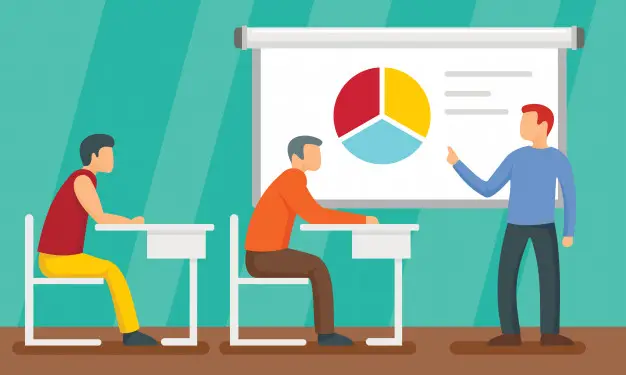According to the context and purpose you have to change your presentation style. Are you stubborn to make a presentation with a similar tone and style that you have kept over the years? Everyone will give a big no! And have a different opinion on how to give a perfect presentation. One group supports visual aids, another thinks visual aids are a threat to both society and the individual. As we know, an individual lacks his/her potential capacity to memorize things using technical devices such as PowerPoint and other presentation platforms. Some other presenters proclaim the benefits of speaking loudly, while another believes the softer you speak the more your audience pays attention. But there is no unanimous opinion on whether you should start your presentation with a quote, story, statistical data, or question. One of the traits that differentiate presenters is whether they like communicating with emotions or data. Some presenters make emotional connections with their viewers, while others prefer to inspire through facts and analytics. There are several presentation styles that maybe suited for your presentation. Check out each one and decide which will be most effective for you. Based on your audience size and subject matter, choose the appropriate style.
Types of presentation styles
1. Visual style
Types of presentation styles
1. Visual style

This style is helpful when speaking to a large audience. Slides will simply complement your talking points and give a visual feast for your audience. With this delivering style, you might need to rehearse little harder to get your audience engaged, but the outcomes can be huge for strong public speakers and storytellers. One of the major advantages of the visual presentation is; you won’t miss any point with the help of slide images. Using visual aids in your presentation can double the chances of meeting your objectives.
2. Freeform style

As the name indicates, this is the impromptu style of public speaking. This unscripted presentation allows the presenters to go any horizon with his thrilling storytelling mode. This presentation doesn’t require slides, instead, the presenter goes with strong stories to illustrate each point. This style works best for those who have excellent knowledge about what he delivers and have a short presentation time only. Further, it is best for networking events, elevators pitches, and unplanned meetings. Freeform style is more conversational with less rehearsal. The unstructured way of presentation can be exciting for others who feel constrained by rules and structure.
3. Instructor style

If you need to get a complex message across, then an instructor method may be most fitted. This presentation approach allows you to deliver complex messages using metaphors, figures, and lots of content; just like the teachers do. Your themes should be a built-in logical order to support the presentation, and you should use impactful visual aids to support your ideas and keep the audience involved. If you have a large set of data or statistical information instructor style would be the best. For example, if you are displaying the features of a newly launched product, which is unfamiliar with you, try instructor style of presenting. However, when used improperly, this style can lose connection with the audience and make you appear detached. When using this approach, try to balance your attention between the material and the spectators.
4. Coach style

Charismatic and energetic speakers are inclined towards this style of speaking. It lets them a link and engage with their audience using role-play and listener interaction. Coach style presentation is largely used by self-help inspirational speakers. You can easily see the passion in what they are saying. Use this style when you are addressing a conference or presenting to a group who needs to be put at ease. This style is suitable for project leaders or managers to get maximum from their subordinates. So if you are about to speak on a topic that interest and stimulates you to share with your audience, then this approach is best.
Keep a balance between talking and getting feedback from your listeners. Avoid talking too fast. Control your voice and tone properly.
5. Connector style
Keep a balance between talking and getting feedback from your listeners. Avoid talking too fast. Control your voice and tone properly.
5. Connector style

By applying this style, you are comfortable both on stage and within the viewers. Connectors normally enjoy freeform Q&A and use excellent control in body language and gestures when they speak. They are inspired by audience reaction and feedback and set an excellent rapport with the audience. Use this style of presenting early in the sales process as you’re learning about your prospect’s goals, challenges, and pain points. This type of speaking sets your listener at comfort, elicits feedback on how you’re doing in real-time and is more of a discussion than a one-sided presentation.
6. Storytelling style

Everyone loves a good story. You can easily handle the audience, and build a connection with them by telling inspiring stories. Storytelling presentation is the most influential one regardless of age and sex. With case studies and axioms, presenters can connect with their audience. Let your emotions out and tell your story in an honest way. The mode is best for conference speaking, networking events, and sales presentations where you have sufficient time to tell your stories. Personality development classes and career planning speeches should be flooded with inspirational stories. Normally, those presenters are natural storytellers who can speak with feeling and rhythm by using powerful stories and words.
Connect your stories with your learning points, otherwise, you will lose your credibility and your speech will become waterlines. So, storytelling style needs hard work and buildup logical connections with the theme.
7. Takahashi style

Takahashi style relies on texts and speech rather than slides. It is a technique that uses simple and refined visuals, particularly large textual fonts. This style is originated in Japan, and named after its creator, Masayoshi Takahashi. It doesn’t include any charts, images or pictures. This style works well for short presentations. It helps the audience read and understand the topic rapidly and focus only on the content, not the graphics. You can design your business presentation slides easily with textual themes by avoiding images and pictures.
Comments
Post a Comment